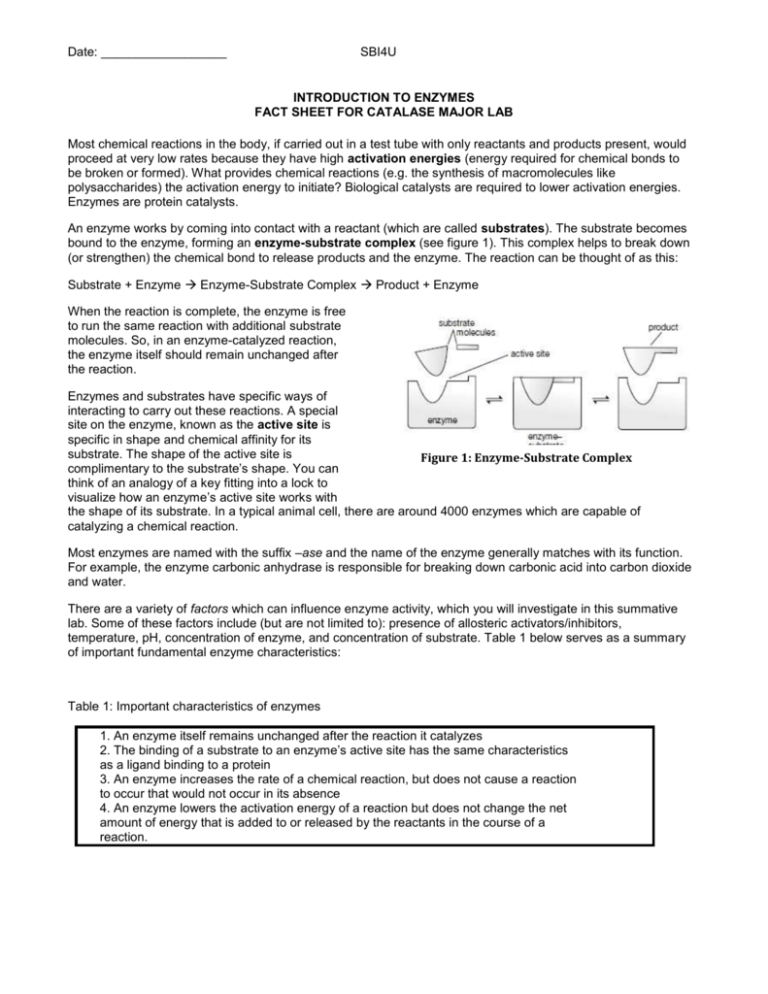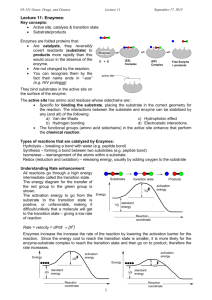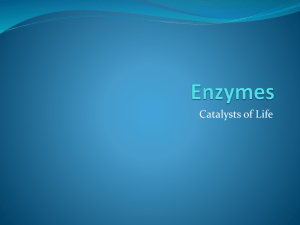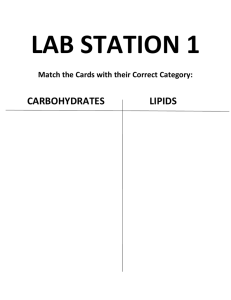Enzymes
advertisement

Date: __________________ SBI4U INTRODUCTION TO ENZYMES FACT SHEET FOR CATALASE MAJOR LAB Most chemical reactions in the body, if carried out in a test tube with only reactants and products present, would proceed at very low rates because they have high activation energies (energy required for chemical bonds to be broken or formed). What provides chemical reactions (e.g. the synthesis of macromolecules like polysaccharides) the activation energy to initiate? Biological catalysts are required to lower activation energies. Enzymes are protein catalysts. An enzyme works by coming into contact with a reactant (which are called substrates). The substrate becomes bound to the enzyme, forming an enzyme-substrate complex (see figure 1). This complex helps to break down (or strengthen) the chemical bond to release products and the enzyme. The reaction can be thought of as this: Substrate + Enzyme Enzyme-Substrate Complex Product + Enzyme When the reaction is complete, the enzyme is free to run the same reaction with additional substrate molecules. So, in an enzyme-catalyzed reaction, the enzyme itself should remain unchanged after the reaction. Enzymes and substrates have specific ways of interacting to carry out these reactions. A special site on the enzyme, known as the active site is specific in shape and chemical affinity for its substrate. The shape of the active site is Figure 1: Enzyme-Substrate Complex complimentary to the substrate’s shape. You can think of an analogy of a key fitting into a lock to visualize how an enzyme’s active site works with the shape of its substrate. In a typical animal cell, there are around 4000 enzymes which are capable of catalyzing a chemical reaction. Most enzymes are named with the suffix –ase and the name of the enzyme generally matches with its function. For example, the enzyme carbonic anhydrase is responsible for breaking down carbonic acid into carbon dioxide and water. There are a variety of factors which can influence enzyme activity, which you will investigate in this summative lab. Some of these factors include (but are not limited to): presence of allosteric activators/inhibitors, temperature, pH, concentration of enzyme, and concentration of substrate. Table 1 below serves as a summary of important fundamental enzyme characteristics: Table 1: Important characteristics of enzymes 1. An enzyme itself remains unchanged after the reaction it catalyzes 2. The binding of a substrate to an enzyme’s active site has the same characteristics as a ligand binding to a protein 3. An enzyme increases the rate of a chemical reaction, but does not cause a reaction to occur that would not occur in its absence 4. An enzyme lowers the activation energy of a reaction but does not change the net amount of energy that is added to or released by the reactants in the course of a reaction. Date: __________________ SBI4U Practice Questions for Understanding: 1. Complete the missing labels a, b, c, and d on the diagram below: 2. Decide if each of the statements below is true or false: a. Enzymes interact with specific substrates _____ b. Enzymes change shape after a reaction has occurred _____ c. Enzymes speed up reactions _____ d. One enzyme can be used for many different types of chemical reactions _____ e. Enzyme reactions can be slowed down or stopped given extreme conditions _____ 3. Without enzymes, reactions would not have enough ________________ to occur. 4. Define the following terms in your own words: o Active Site o Substrate o Activation Energy 5. Complete the blanks in the following passage: Enzymes are biological ___________________. They ________________ the rate at which chemical reactions occur in living cells. They are organic compounds composed of ___________ macromolecule. Enzymes are Date: __________________ SBI4U important facilitators of energy-transforming reactions, recycling processes, synthesis of some biomolecules and breakdown of biomolecules,








